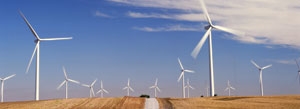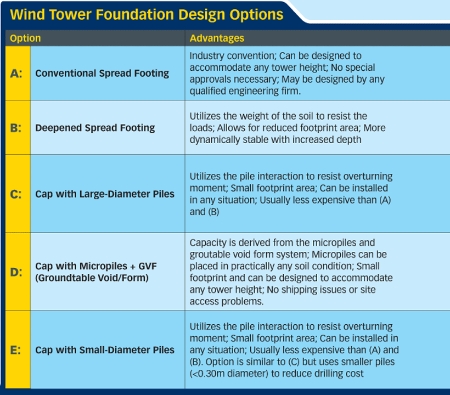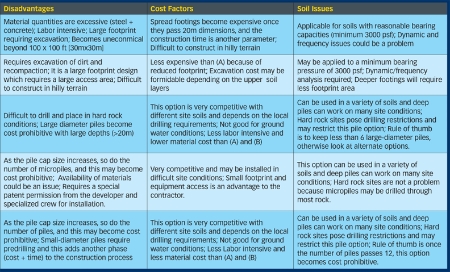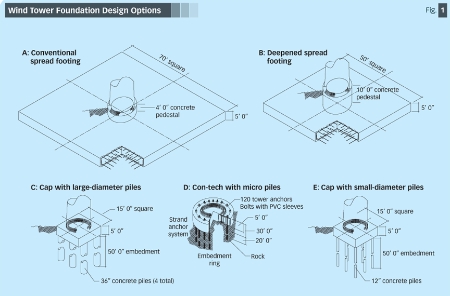Economics of Taller Wind Towers
The wind power industry is growing with the trend towards taller towers and larger turbine capacity. Over the past 20 years, the wind energy turbine tower has grown from 40 meters to 90 meters with turbine sizes reaching 2.5 MW. As we progress into the 21st century, the 4.0-MW and 8.0-MW turbine is on the horizon along with towers exceeding 100 meters in height.
 Wind
energy capacity curves improve with height because the wind
profile is stronger. This article analyzes the economics of
taller towers and provides a parametric study of tower height
vs. power curve. How does the additional cost of taller towers
improve the power curve? Is it economical to keep adding height
and turbine size? The financial metrics are discussed and a
value engineering analysis is presented with conclusions and
recommendations for future wind tower design.
Wind
energy capacity curves improve with height because the wind
profile is stronger. This article analyzes the economics of
taller towers and provides a parametric study of tower height
vs. power curve. How does the additional cost of taller towers
improve the power curve? Is it economical to keep adding height
and turbine size? The financial metrics are discussed and a
value engineering analysis is presented with conclusions and
recommendations for future wind tower design.The wind energy industry has a short history in our industrial market that starts in the late 1960s. Nevertheless, wind power has existed for over 500 years and evidence exists of wind power utilized by Europeans and Babylonians for their food production process. Our focus, however, is on the immediate present.
Wind energy started with 40m to 50m towers that supported 400-kW to 660-kW turbines. These structures were mostly a truss tower type and still can be seen in certain "wind farm cradles of civilization" such as Palm Springs, Calif. Many of these original designs are still in production, although they require frequent maintenance and the turbines are outdated. These behemoths stand as the cornerstone of the modern wind energy industry. Definitely not attractive designs, they symbolize the start of this growth curve in our demand for clean energy. [Editor's note: The chart below is a two-page spread in the print edition. Imagine the bottom half of the chart attached to the right of the top half. We apologize for the small print.]

chart continues as if across the page.

From the late 1970s to the 1990s, the industry remained below the 50m tower height limitation because the wind energy industry went through several cycles of growth and collapse. As we progress to the late 1990s, turbine technology shifted to 800-kW to 1.0-MW machines and tower hub heights reached 60m and 70m. Turbine technology demanded larger rotor diameters and thus taller towers. It finally became apparent that it was cheaper to construct fewer wind towers with larger capacity because this would reduce the total infrastructure cost.
To move forward with 1.0-MW and 1.5-MW machines, the towers became tubular steel structures and foundation design solutions were needed to solve the ever-growing load demand on the structure. These tubular steel structures have become the mainstay of the wind tower market.
After 2000, the turbine market has heated up and reached new levels of capacity. We are now in the age of renewable energy with increasing demand for this product. New tower technology is necessary to keep up with the industry.
Turbine Sizes and Clean Energy Demand
The past 10 years have seen a flurry of growth for new turbine technology due to the pent-up demand globally for green energy sources. The worldwide market for renewable energy is growing and has a positive outlook for the next 10 years. Turbine sizes are averaging 2.0-MW to 3.0-MW for onshore projects, with new turbines developed at the 4.0- and 5.0-MW sizes. These all require towers of 80m minimum hub heights. For the onshore market, the 3.0 MW turbines are fast becoming the standard, with 90m tower heights.

For offshore wind, which is still in its infancy globally, the minimum turbine sizes are 5.0-MW and growing to 7.0-MW. In this author's opinion, the offshore market will continue to grow because ultimately that is where the highest efficiency curves are obtained. High capacity factors translate into stronger financial performance, which further excites the investment community and stimulates more capital inflow.
The American Wind Energy Association (AWEA) website states that 8,500 MW of wind power generation was added in 2009. This is equivalent to 8.5 GW or approximately nine medium-sized nuclear power plants. The industry is poised for growth.
New Turbine Technology and Cost Factors
New turbines are being developed for 7.0-MW and 10.0-MW capacities that require 100m rotor diameters and minimum 100m tower heights. Larger turbines allow fewer towers to do the work of many smaller turbines. A simple arithmetic exercise shows the economic advantages:
Example of 100-MW onshore wind farm:
-
25 towers @ 4 MW
25 towers @ $500k/tower = $12.5 million in structure + foundation
10 miles roads @ $1.5 million/mile = $15 million
Total infrastructure cost = $27.5 million or $275,000/MW
100 towers @ 1 MW
100 towers @ $350k/tower = $35 million in structure + foundation
50 miles of roads @ $1.5 million/mile = $75 million of road
Total infrastructure cost = $110 million = $1,100,000/MW
By increasing the tower size and turbine capacity, we can reduce the infrastructure cost tremendously. There are numerous additional advantages to having fewer towers per project:
- Less environmental impact overall; fewer roads, which means a smaller area of the site is impacted with construction traffic
- Less earthwork and grading impact
- Taller towers with larger turbines results in low frequency rotation of the rotor (<15 rpm), which means less bird impact issues (birds can detect the lower rotation blades and divert their flight path)
- Fewer turbines means overall lower maintenance cost because there are less machines to monitor; it's easier to monitor 25 towers versus 100.
Taller towers that are becoming the mainstream and reaching heights above 100m fuel demand for creative engineering solutions. Several firms are pursuing innovative tower designs. The main ideas focus on using the basic tubular steel tower concept, but numerous alternative design concepts use composite towers with steel and concrete. Technical challenges are posed in tall towers and the structural engineering aspects become complicated.
Here are 12 issues that confront structural engineers in tower design:
The most unique aspect of wind tower structural design is the dynamic characteristics and fatigue-elated issues. Of all civil engineered structures, the wind tower stands as an inherently special structure because it is a "working machine" with moving parts, versus a bridge or high rise building. These inherent dynamic loads create many issues that are not normally considered in static structures.
Long-term loads are the normal operational wind loads that include dead, live, static wind pressure and standard operational overturning moments, shears and axial loads. The frequency of these long-term sustained loads may reach over 20,000,000 cycles in 20 years. Therefore, every aspect of the tower-foundation design must consider these provisions. Short-term loads include E-stop, earthquake, peak wind dynamic pressure and three-second gust load.
For offshore projects, the issues are further compounded with additional technical complexities:
- Hydrodynamic wave loading on the tower foundation
- Frequency response of tower-foundation with complexity of the wind and water wave action on the structure
- Fatigue and corrosion from the water-wave action
- Submarine access to the foundation for monitoring and maintenance
- Geotechnical performance of the sub-sea floor foundation behavior.
Furthering this discussion for taller towers are the foundation elements that must complement the larger structure and increased loads.
Wind towers continue to grow in height and load capacity. We are now looking at the next generation of wind towers which will exceed 100m in height and carry 7.0 MW and larger-sized turbines. In this author's estimation, we will see the average tower height be 120m by 2015 with 7.0 MW turbines as the typical case.
As we move forward, we can improve our design practice by developing an inventory of towers and asking difficult questions. Areas for further research include:
Structural Performance Monitoring: Monitor a select sample size of towers to keep a track record of their loads, stresses and performance.
Comprehensive Research on Structural Failures: A research report should be commissioned to examine the inventory of tower designs and documented failures. Little information exists on this topic in the research community and we need more information.
Evaluation of All Load Conditions: There is a lack of information on the scope of design loads and what they should include. Perhaps a revised standard is warranted to form uniform platform for all manufacturers.
Sharing our Design Problems for Discussion: Our technical teams should communicate and share their successes and problems. The best way to improve is to discuss these in an open forum.
Statistical Record Keeping: As an industry, we should be keeping records of problems and issues so that we can track the performance of various systems.
Improving the Design Codes: All of these efforts should be consolidated into a wind tower structural design committee that can recommend improvements to our design codes.
Dr. Dilip Khatri is Principal Structural Engineer with the URS Corp. in Los Angeles and has 27 years of experience in all areas of civil engineering. He has worked in the wind energy industry for 10 years designing towers, foundations and civil projects. His experience in the seismic and earthquake engineering industry includes conducting numerous insurance investigations into commercial loss along with investigating failures for commercial line carriers. Dr. Khatri has extensive experience with tall structures, dynamic analysis, earthquake response and construction of complex structural systems and infrastructure design. He has published over 30 technical papers, two textbooks and conducted over 100 symposiums and conferences internationally.
 To subscribe or visit go to:
http://www.renewableenergyaccess.com
To subscribe or visit go to:
http://www.renewableenergyaccess.com